ASRock Rack 1U4LW-B650/2L2T Topology and Block Diagram
Here is the topology of the system:
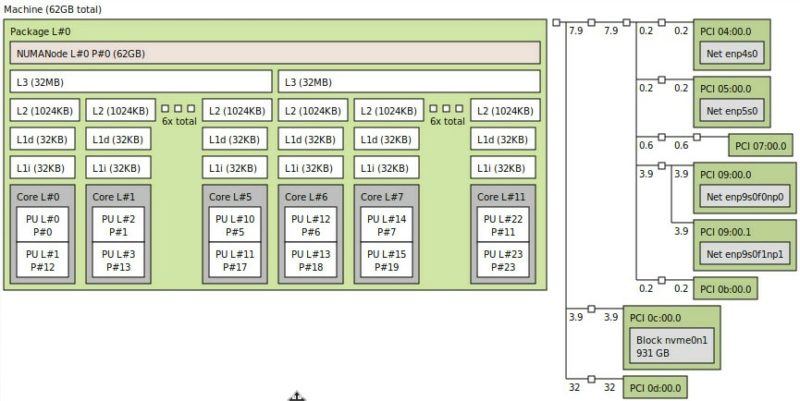
Here is the block diagram of the motherboard to help folks understand how everything is connected:
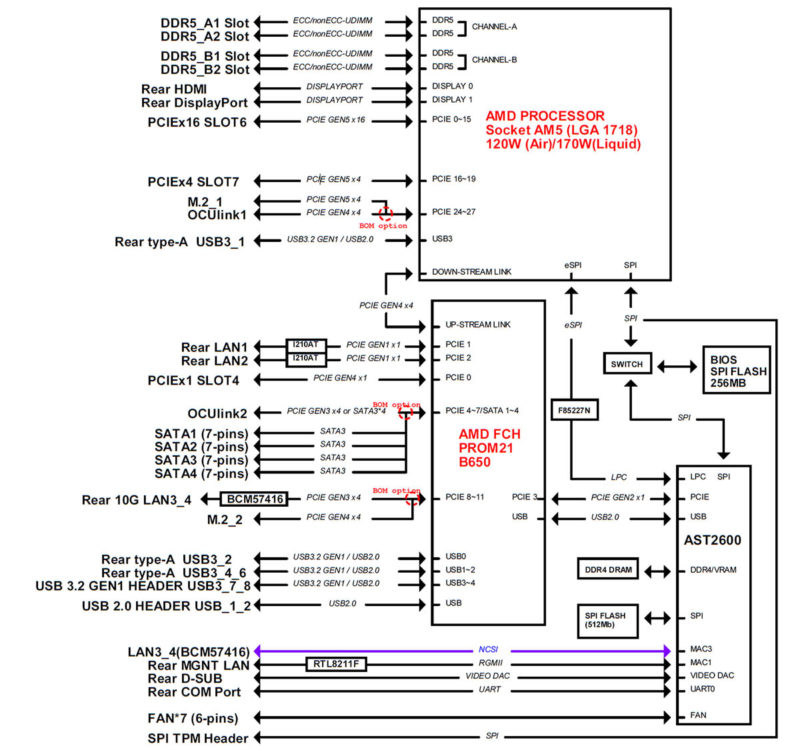
Here, the big BOM option being taken advantage of is the Broadcom BCM57416 for the 10Gbase-T module.
ASRock Rack 1U4LW-B650/2L2T Management
The ASRock Rack 1U4LW-B650/2L2T has an onboard ASPEED AST2600 BMC. As such, it has a management interface for out-of-band management.
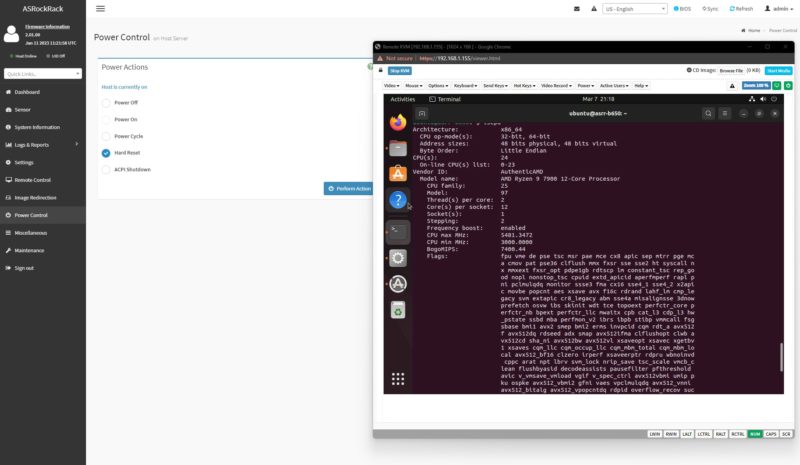
That means we get an updated ASRock MegaRAC IPMI management interface (and Redfish API) solution versus what we saw on the older platforms.
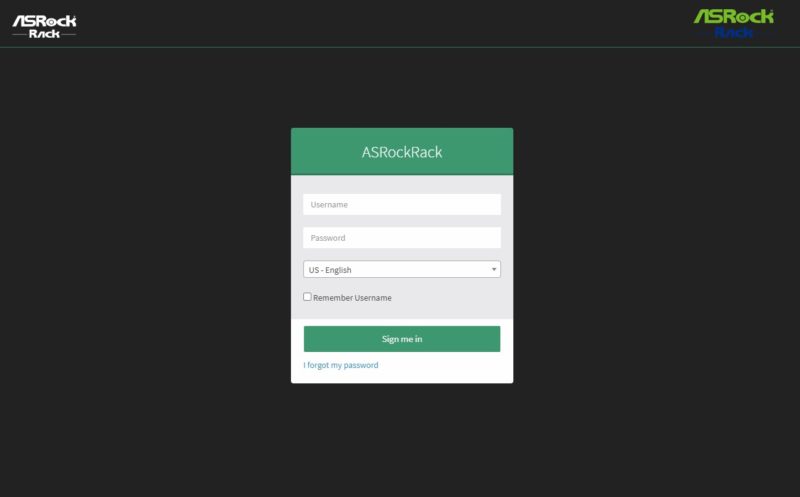
That includes features like HTML5 iKVM functionality included.
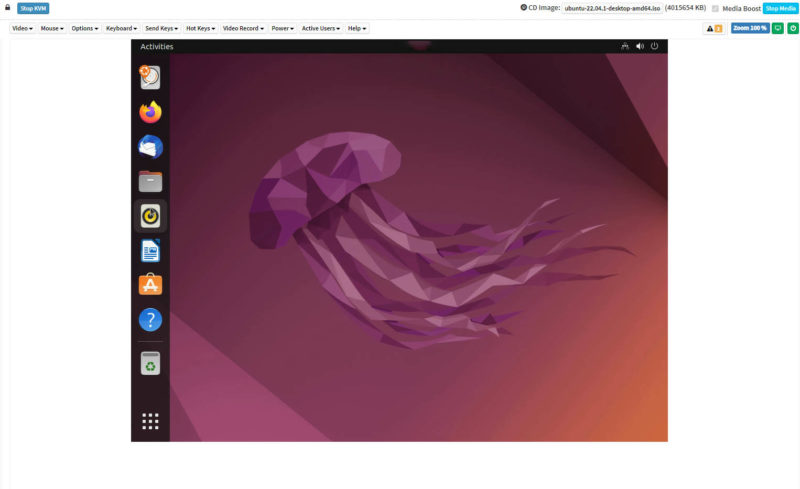
Recently, Supermicro made a change to licensing the remote media mounting feature that we covered in: How to Add Virtual Media to a Supermicro Server via HTML5 iKVM Web IPMI Interface. ASRock Rack does not charge for this feature and it is one that many admins use.
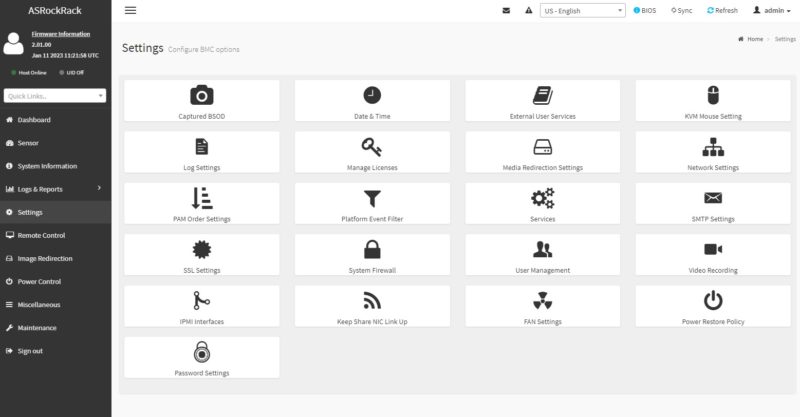
The new platform still uses the default username and password of admin / admin, but it now has a requirement to change the password after the first boot:
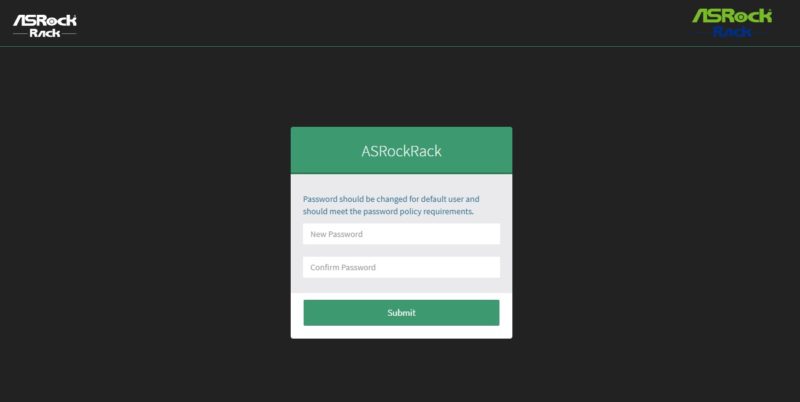
You can learn more about why this is required so the old ADMIN/ ADMIN credentials will not work in Why Your Favorite Default Passwords Are Changing.
Next, let us get to the performance and our final thoughts.
ASRock Rack 1U4LW-B650/2L2T Performance
On the performance side, the one item we wanted to check for was that the chips were running at full speed, or near full speed. We had AMD Ryzen 9 7900 data from the Falcon Northwest Talon AMD Ryzen 9 7950X workstation we reviewed and wanted to use that as a baseline.
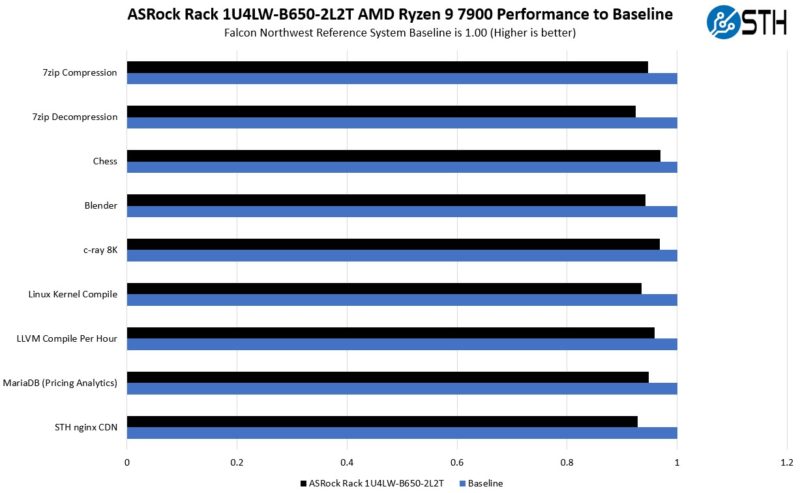
Between the gaming motherboard, DDR5-5600 memory, and such, the gaming platform was faster, but the ASrock Rack server platform was generally only 1-5% off. That is very close.
The AMD Ryzen 9 7900 should be an existential threat to Intel. Just for a quick and easy look, here is Geekbench 5 with this 1U server versus the Lenovo ThinkStation P360 Ultra we just reviewed.
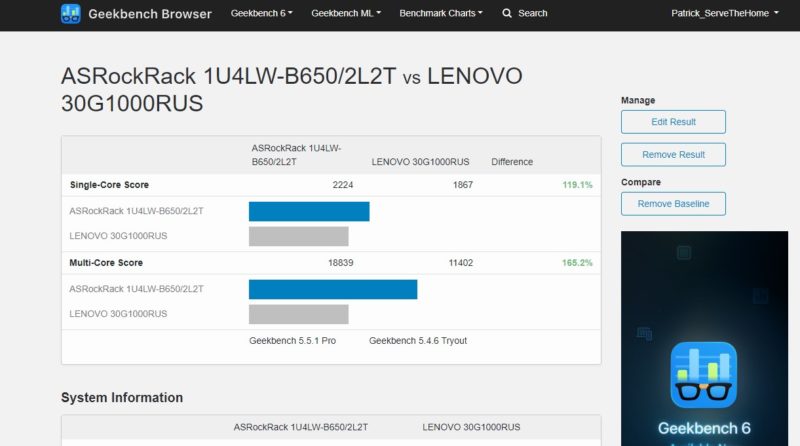
Geekbench 6 is not a good mutli-core benchmark, but here is that look:
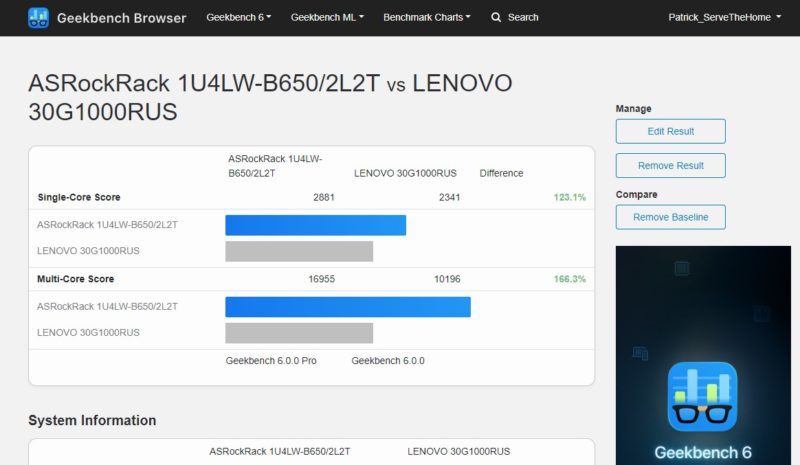
For some reference, the 65W Intel Core i9-12900 peaked at much higher power loads as well. The AMD Ryzen 9 7900 would not go above 100W. For a server, that is important since it means it can be deployed into power-constrained environments.
Going beyond just the direct competition, let us take the Intel Xeon D-1749NT we just reviewed. To be fair to that part, the Xeon D-1700 line often has integrated 25GbE and QAT, but the D-1749NT is a 90W TDP part that will use more power than this AMD Ryzen 9 7900 setup.
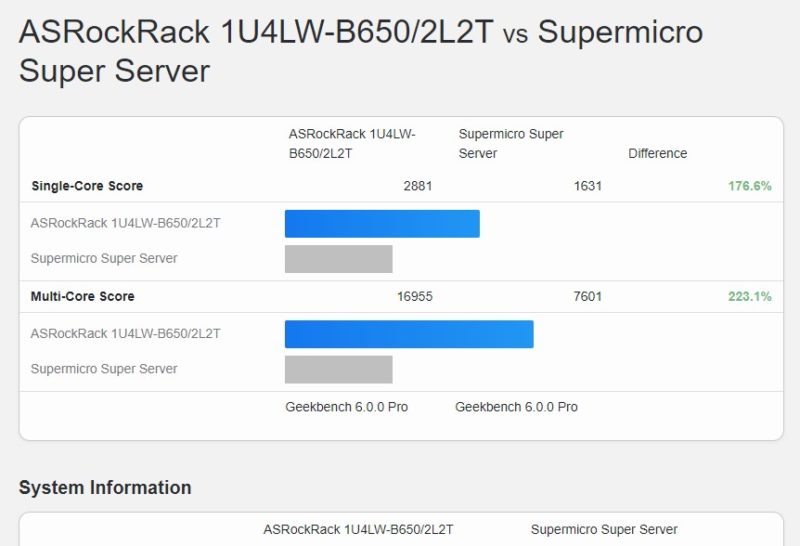
Here are the Geekbench 5 results:
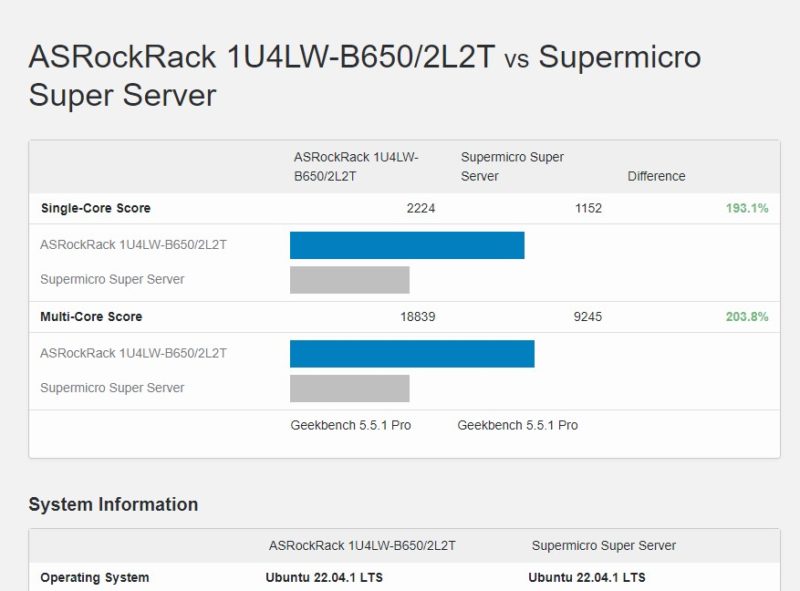
There are tons of numbers out there for the AMD Ryzen 9 7900. Many are tuned with higher memory speeds like the Falcon Northwest desktop system. At the same time, AMD has a very apparent price/ performance leadership role over Intel, especially once power is factored into the equation.
The one feature we wish AMD had, but it is harder with the DDR5 UDIMM/ RDIMM split, is ECC RDIMM support. ECC RDIMM support would bring it to a different level against the Xeon D series and would effectively be an endgame product (on a price/ performance/ power basis) over Intel’s single socket server line. AMD just has not committed enough to this type of server deployment to support it like Intel does the Xeon E/ W680 platforms and the Xeon D platforms.
We are discussing power consumption, so let us take a look at that.

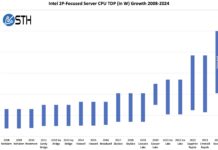


Patrick, you say the CPU matters. Does this mean that the motherboard does not have the usual options to set a custom (lower) power limit? If it does have that option, it might be even better in terms of the flexibility it offers. Particularly for home lab setups that would be a nice feature.
Jorik – Great question. Just added a screenshot of the AMD Overclocking menu in the BIOS so there are levers to tweak.
Hopefully there is the “Eco Mode” option in the bios, or a way to manually recreate it so you can run the X series chips at a reasonable power limit, but still have the option to let it run hot if needed?
Any word on availability and pricing?
Regarding Joriks question:
Is ECO mode available in BIOS like on all desktop boards?
That would allow anyone to bring TDP down to low levels on -X CPUs(105W for 7950X) in a very safe and easy way. Even simpler than setting TDP manually.
Exciting! Patrick, I pulled the mainboard user manual but it only says “frequency and voltage” are in the overclock section (no details given). Can you advise if one can dial in a maximum power (watts) or amps (e.g. via PBO or Curve Optimizer)?
A 7950x, power limited to ~95-105W actual max socket power would be killer in this system if one needs the cores.
7950X3D now
If the motherboard allows you to set TjMAX, then that could also be a very practical lever to pull. On the 7000 series the boost algorithm seems to be quite adept at taking the programmed thermal constraint into account, it is not a hard thermal throttling of yesteryear.
Setting TjMAX to, say, 75 °C should greatly reduce power consumtion in a way that will actually adapt to changes to ambient temperature.
Platforms like this are very appealing for the price/performance/power figures. Let me just get right to my question: 32GB DDR5 UDIMM sticks are a known quantity. Apparently 48GB sticks were recently released as well. What does the future hold for 64GB (or 72/96GB) modules? What does STH (and its readers) think the limit will be for ECC UDIMM module size and when? Related question: DDR4 UDIMMs have topped out at 32GB and we will never see larger, correct?
Looking at the product page for just the motherboard it says the x16 slot is PCIE 5.0, seems like it’s 4.0 on this server though. Is that just the riser being 4.0 I wonder?
@AustinP
I think 64 GB DDR5 UDIMMs will surely be made, but it will take a while. Much like SRAM, DRAM density is also pushing up against the walls of physics and silicon harder than ever. You can only make the capacitors so thin and the electrons so few before your DRAM turns into a hardware RNG device. We are almost certainly in the diminishing returns era of DRAM manufacturing.
AFAIK DDR4 is slowly creeping towards being phased out, there is negligible chance that anyone will make higher density DDR4 DRAM chips now.
Doesn’t the Xeon E series lack RDIMM support anyways?
When compared against that… I don’t think theres anything missing in the actual spec sheets anymore vs the Xeon E series.
As it was not mentioned, one would assume this suffers the same issue list as other am5 mobos if you put 128GB of RAM in the slots?
It’s look interesting, but only one m.2 slot and maximum 32GB module memory is big mistake:-/
Now I’m interested (and sold), this server could fit perfectly for a devlopment env, or even homelab.
Only four SATA and one M.2 slot. Meh..
The problem with Ryzen 7000 (and Intel 13000) is that enormous single x16 pcie5 slot. Nobody outside the hyperscalers needs that slot. The solution to that is splitting it to x16/x0 or x8/x8 depending on what is populated. This ‘server’ does not fix the problem.
I hope to see more Ryzen server motherboards like the one in this server. Like other commenters, I’d like to see more PCIe slots. Also would like to accommodate 110mm M.2 and large low noise heatsink/fan for use at home. uATX / ATX layout would be great. I’d prefer to skip the integrated 10G, I’d want SFP+ anyway. Give me an extra PCIe slot to install what I want instead.
I have been using 5950x server for some time … very fast.
I am very curios to see how this gen is performing.
This really is a pedestal board, not a 1U board. You can find boards (for other CPU sockets) where much of the PCIe is brought out in x8 cabled sockets. SFF8654, SlimSAS, not sure I remember the name correctly. These boards are good for 1U: you can wire up nvme backplanes, or run a load of SATA if the board is made right.
Anyway the PCIe lanes on this thing are mostly wasted by the case form factor. People who want a home Ryzen 7000 server: build a pedestal or 2U or 4U server using this board, you will have a much more useful machine.
ASRock Rack does have some interesting M.2 risers for 1U platforms. Like the RB1U2M2_G4 and RB1U4M2_G4. I would be curious so see multiple RB1U4M2_G4 models in a 1U tested. Could be nice for space starved homelabs.
Wish the 2 drive model was 8x instead of 16x.
Tested the non 10G version of this board yesterday (B650D4U) with Ryzen 7950 cpu and dynatron 1U watercooling, power is impressive (61500 cpu marks) but power draw is peaking at 325 watts for the whole server during geekbench 6..
With upgraded fans, the Dynatron handles it quite well (83 – 89°), still 325watts is a lot in datacenter environnement.
Will order a 7900X cpu to compare powerdraw and benchmark results.
https://browser.geekbench.com/v6/cpu/468424
https://www.passmark.com/baselines/V10/display.php?id=503406055051
Does anyone know if the x16 slot supports bifurcation? I didn’t see anything in the manual about it but figured I’d ask. Getting one of these is mighty tempting, I just wish it had a little more PCIe.
Does anyone have confirmation on whether the Broadcom BCM57416 supports NBase-T speeds? From what I’ve seen it does not, but I’m hoping someone with experience can confirm one way or another.
Patrick (or anyone with hands on experience), you reference the noise of the unit briefly, but don’t show it in the video. Just how bad is it?
We currently use Dell Precision 3930 Rack workstations for field deployments, and I think this with a 7900 would make an excellent next step up in CPU performance. But we do operate in close proximity to the servers. The Dells are practically silent in less than 60% lost.
Hi Patrick,
I would be interested in the total power consumption using the 7950@105W (ECO). Would this be possible?
Where can I buy this?
@Pete
https://www.asrockrack.com/general/buy.asp
My only problem with your reviews is that you do not mention anything about what “server” OS you are testing these with and what kind of issue or not that you have had with installing said OS. Please expand into the OSes that will run on these hardware platforms, specifically server OSes. – Thank you.
Package idle is pretty uninteresting. What draws the system from the wall in idle?
This is really an impressive piece! We got one from local disti in Australia (wisp.net.au) and thinking to order another one. Apparently more units coming end of July, if anyone is from down under
@netswitch
What mounting bracket and upgraded fans are you using?
I cant seem to find a compatible bracket for AM5 for this cooler, only AM4
Could someone post IOMMU groups?
IOMMU groups
[ 0.405364] iommu: Default domain type: Translated
[ 0.405364] iommu: DMA domain TLB invalidation policy: lazy mode
[ 0.423218] pci 0000:00:01.0: Adding to iommu group 0
[ 0.423235] pci 0000:00:02.0: Adding to iommu group 1
[ 0.423246] pci 0000:00:02.1: Adding to iommu group 2
[ 0.423257] pci 0000:00:02.2: Adding to iommu group 3
[ 0.423272] pci 0000:00:03.0: Adding to iommu group 4
[ 0.423286] pci 0000:00:04.0: Adding to iommu group 5
[ 0.423303] pci 0000:00:08.0: Adding to iommu group 6
[ 0.423313] pci 0000:00:08.1: Adding to iommu group 7
[ 0.423323] pci 0000:00:08.3: Adding to iommu group 8
[ 0.423343] pci 0000:00:14.0: Adding to iommu group 9
[ 0.423356] pci 0000:00:14.3: Adding to iommu group 9
[ 0.423408] pci 0000:00:18.0: Adding to iommu group 10
[ 0.423418] pci 0000:00:18.1: Adding to iommu group 10
[ 0.423428] pci 0000:00:18.2: Adding to iommu group 10
[ 0.423445] pci 0000:00:18.3: Adding to iommu group 10
[ 0.423455] pci 0000:00:18.4: Adding to iommu group 10
[ 0.423471] pci 0000:00:18.5: Adding to iommu group 10
[ 0.423482] pci 0000:00:18.6: Adding to iommu group 10
[ 0.423491] pci 0000:00:18.7: Adding to iommu group 10
[ 0.423502] pci 0000:01:00.0: Adding to iommu group 11
[ 0.423513] pci 0000:02:00.0: Adding to iommu group 12
[ 0.423523] pci 0000:02:01.0: Adding to iommu group 13
[ 0.423534] pci 0000:02:02.0: Adding to iommu group 14
[ 0.423544] pci 0000:02:03.0: Adding to iommu group 15
[ 0.423555] pci 0000:02:04.0: Adding to iommu group 16
[ 0.423565] pci 0000:02:08.0: Adding to iommu group 17
[ 0.423577] pci 0000:02:0c.0: Adding to iommu group 18
[ 0.423587] pci 0000:02:0d.0: Adding to iommu group 19
[ 0.423590] pci 0000:04:00.0: Adding to iommu group 13
[ 0.423593] pci 0000:05:00.0: Adding to iommu group 14
[ 0.423596] pci 0000:06:00.0: Adding to iommu group 15
[ 0.423599] pci 0000:07:00.0: Adding to iommu group 15
[ 0.423603] pci 0000:09:00.0: Adding to iommu group 17
[ 0.423606] pci 0000:09:00.1: Adding to iommu group 17
[ 0.423608] pci 0000:0a:00.0: Adding to iommu group 18
[ 0.423611] pci 0000:0b:00.0: Adding to iommu group 19
[ 0.423622] pci 0000:0c:00.0: Adding to iommu group 20
[ 0.423645] pci 0000:0d:00.0: Adding to iommu group 21
[ 0.423658] pci 0000:0d:00.1: Adding to iommu group 22
[ 0.423669] pci 0000:0d:00.2: Adding to iommu group 23
[ 0.423679] pci 0000:0d:00.3: Adding to iommu group 24
[ 0.423690] pci 0000:0d:00.4: Adding to iommu group 25
[ 0.423701] pci 0000:0d:00.5: Adding to iommu group 26
[ 0.423712] pci 0000:0d:00.6: Adding to iommu group 27
[ 0.423722] pci 0000:0e:00.0: Adding to iommu group 28
[ 0.649911] perf/amd_iommu: Detected AMD IOMMU #0 (2 banks, 4 counters/bank).
What about TPM 2.0 supported by VMware? we have a tried the TPM-SPI 2.0 but VMware didn’t accept with internal error message. Anyone know the exact proper bios configuration? running bios 10.18